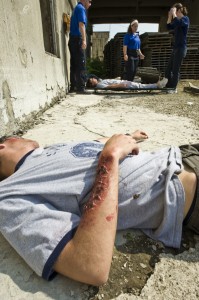
As the exercise unfolds, seemingly lifeless bodies litter the ground. One victim stumbles around with a chest wound that peers out from a torn, bloody T-shirt. Moaning patients with blood-smeared faces are helped on to stretchers.
As disasters go, it was a big one.
A monster Category 5 hurricane slams into a U.S. coastal community. Buildings collapse. An airplane crashes. Some residents are dead. Others are bloodied and dazed.
This frightening scenario played out May 11 in a mass casualty training exercise at Wright State University’s National Center for Medical Readiness at Calamityville. It was the second major exercise at Calamityville, a 55-acre site in Fairborn that was once home to a cement factory.
Dr. Glenn Hamilton, professor of emergency medicine at Wright State’s Boonshoft School of Medicine and senior director of Calamityville, said the exercise was designed to have military and civilian medical first responders—who often don’t speak a common technical language–interfacing in a realistic, mock disaster setting.
“Our whole goal today is really to bring an exercise that allows the civilian/military sides to work together and start to develop a more common understanding of capability,” Hamilton said.
As the exercise unfolds, seemingly lifeless bodies litter the ground. One victim stumbles around with a chest wound that peers out from a torn, bloody T-shirt. Moaning patients with blood-smeared faces are helped on to stretchers.
“We’re very, very fortunate here to have something like Calamityville because we can set up scenarios like they may see when we actually deploy in the settings like Afghanistan and Iraq,” said Col. Eric Nelson, director of medical education for the 88th Medical Group at Wright-Patterson Air Force Base. “We’ll see multiple injuries. We’ll see mass casualties.”
Hamilton said Calamityville, located near Wright State and Wright-Patterson and boasting a large concrete structure, a maze of tunnels and other built-in props, is the perfect site for such an exercise.
“This is the only exercise training environment that’s sponsored by a medical school in this country,” he said. “Our goal has always been to bring that medical side further out into the field, test new equipment and test new processes. And that’s what this site will let us do.”
The tail of the “crashed” airplane pokes out from a towering concrete silo and gives off a plume of white smoke. The “victims’” screams for help are chilling.
“Oh my God. Get me out of here,” one yells.
The evacuation helicopter—an Army Blackhawk from Columbus–lands with a gentle bounce, kicking up swirling clouds of dust and leaving the smell of aircraft fuel hanging in the air.
It will ferry the victims to a makeshift field hospital at Wright-Patterson. After the victims are triaged, they will then be transported by a C-17 cargo plane.
“So what we’ll be able to see is the full initial response, patient evacuation and then kind of working through the military medical evacuation system,” said John Dorsch, a chief resident in the Wright-Patterson/Wright State University Emergency Medicine Residency program.
More than 50 people from Wright State and Wright-Patterson alone took part in the exercise. Others included the 1-137th Aviation Battalion of the Ohio National Guard, the Civil Air Patrol, Miami Valley Hospital and the Fairborn Fire Department.
- Calamityville gives military and medical personnel a place to set up scenarios like they may see when they actually deploy in the settings like Afghanistan and Iraq with multiple injuries and mass casualties.
- Calamityville is the only exercise training environment that’s sponsored by a medical school in the country.
- More than 50 people from Wright State and Wright-Patterson alone took part in the exercise. Others included the 1-137th Aviation Battalion of the Ohio National Guard, the Civil Air Patrol, Miami Valley Hospital and the Fairborn Fire Department.
- It was the second major mass casualty exercise at Calamityville, a 55-acre site in Fairborn that was once home to a cement factory.
- As the exercise unfolds, seemingly lifeless bodies litter the ground. One victim stumbles around with a chest wound that peers out from a torn, bloody T-shirt. Moaning patients with blood-smeared faces are helped on to stretchers.
- The exercise was designed to have military and civilian medical first responders—who often don’t speak a common technical language–interfacing in a realistic, mock disaster setting.
- The Calamityville site, located near Wright State and Wright-Patterson Air Force Base and boasting a large concrete structure, a maze of tunnels and other built-in props, is the perfect site for mass casualty exercises like this one from May 2011.

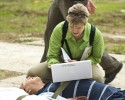
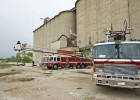
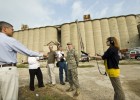
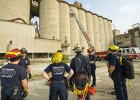
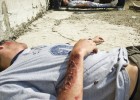

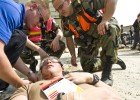
 Bottom Line, Wright State partnership aims to increase access to college
Bottom Line, Wright State partnership aims to increase access to college  Wright State’s nursing program celebrates 50th anniversary
Wright State’s nursing program celebrates 50th anniversary  Wright State celebrates Student Success Champions
Wright State celebrates Student Success Champions  Wright State gold team captures 2024 Horizon League team title, Flynn individual champion
Wright State gold team captures 2024 Horizon League team title, Flynn individual champion  118 medical students to graduate from Wright State’s Boonshoft School of Medicine April 28
118 medical students to graduate from Wright State’s Boonshoft School of Medicine April 28 